Drosophila suzukii
Drosophila suzukii, commonly called the spotted wing drosophila or SWD, is a fruit fly. D. suzukii, originally from southeast Asia, is becoming a major pest species in America and Europe, because it infests fruit early during the ripening stage, in contrast with other Drosophila species that infest only rotting fruit.[2]
| Drosophila suzukii | |
|---|---|
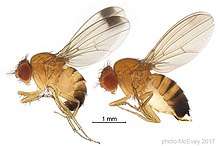 | |
| Male and female Drosophila suzukii | |
| Scientific classification | |
| Kingdom: | |
| Phylum: | |
| Class: | |
| Order: | |
| Family: | |
| Genus: | |
| Subgenus: | |
| Species group: | |
| Species subgroup: | D. suzukii species subgroup |
| Species: | D. suzukii |
| Binomial name | |
| Drosophila suzukii (Matsumura, 1931)[1] | |
Native to southeast Asia, D. suzukii was first described in 1931 by Matsumura. Observed in Japan as early as 1916 by T. Kanzawa,[3] D. suzukii was widely observed throughout parts of Japan, Korea, and China by the early 1930s.[3] By the 1980s, the “fruit fly” with the spotted wings was seen in Hawaii. It first appeared in North America in central California in August 2008[4] and is now widespread throughout California's coastal counties,[5] western Oregon, western Washington,[4] and parts of British Columbia[6] and Florida.[7] During the summer of 2010 the fly was discovered for the first time in South Carolina, North Carolina,[8] Louisiana,[9] and Utah.[10] In Fall 2010 the fly was also discovered in Michigan[11] and Wisconsin.[12] The fly was first discovered in the northeastern states in 2011[13] and in Minnesota in 2012.[14] As D. suzukii continues to spread, most of the states will most likely observe it. The pest has also been found in Europe, including the countries of Belgium, Italy, France, and Spain.[15][16]
D. suzukii is a fruit crop pest and is a serious economic threat to soft summer fruit; i.e., cherries, blueberries, raspberries, blackberries, peaches, nectarines, apricots, grapes, and others.[4] Research investigating the specific threat D. suzukii poses to these fruit is ongoing.[17]
Description
Like other members of the Drosophilidae, D. suzukii is small, approximately 2 to 3.5 mm in length and 5 to 6.5 mm in wingspan [3] and looks like its fruit and vinegar fly relatives. Its body is yellow to brown with darker bands on the abdomen and it has red eyes. The male has a distinct dark spot near the tip of each wing; females do not have the spotted wing. The foreleg of the male sports dark bands on the first and second tarsi. The female has a long, sharp, serrated ovipositor.[18] The larvae are small, white, and cylindrical reaching 3.5 mm in length.[4]
When first observed in a new region, D. suzukii has often been confused with the western cherry fruit fly (Rhagoletis indifferens) and was given the short-lasting name cherry vinegar fly.[19] The cherry fruit fly is significantly larger than D. suzukii (up to 5 mm) and has a pattern of dark bands on its wings instead of the telltale spot of D. suzukii. The telltale spots on the wings of male D. suzukii have earned it the common name "spotted wing drosophila" (SWD).
Unlike its vinegar fly relatives which are primarily attracted to rotting or fermented fruit, female D. suzukii attack fresh, ripe fruit by using their saw-like ovipositor to lay eggs under the fruit's soft skin. The larvae hatch and grow in the fruit, destroying the fruit's commercial value.
Lifecycle
The lifespan of D. suzukii varies greatly between generations; from a few weeks to ten months.[3] Generations hatched early in the year have shorter lifespans than generations hatched after September.[3] Research shows that many of the males and most of the females of the late-hatching generations overwinter in captivity—some living as long as 300 days. Only adults overwinter successfully in the research conducted thus far. In Washington state, D. suzukii has been observed in association with two exotic and well-established species of blackberry, Rubus armeniacus (= Rubus discolor) and Rubus laciniatus (the Himalayan and Evergreen Blackberries, respectively.).[4] The fly has been observed reproducing on many other species of soft-skinned wild fruit, however, research is still ongoing to determine the quality of individual species as reproductive hosts.
Adults emerge from overwintering when temperatures reach approximately 10 °C (268 degree days).[4] The fertilized female searches for ripe fruit, lands on the fruit, inserts its serrated ovipositor to pierce the skin and deposits a clutch of 1 to 3 eggs per insertion. Females will oviposit on many fruits and in regions of scarce fruit, many females will oviposit on the same fruit. In captivity in Japan, research shows up to 13 generations of D. suzukii may hatch per season. A female may lay as many as 300 eggs during its lifespan. With as many as 13 generations per season, and the ability for the female to lay up to 300 eggs each, the potential population size of D. suzukii is huge. It is also important to note that males of D. suzukii become sterile at 30 °C and population size may be limited in regions that reach that temperature.
The larvae grow inside the fruit. The oviposition site is visible in many fruit by a small pore scar in the skin of the fruit often called a "sting". After 1 or 2 days, the area around the "sting" softens and depresses creating an increasingly visible blemish.[4] The depressions may also exude fluid which may attract infection by secondary bacterial and fungal pathogens.[5] Larvae may leave the fruit, or remain inside it, to pupate.
Economic impact
The economic impact of D. suzukii on fruit crops is negative and significantly affects a wide variety of summer fruit in the United States including cherries, blueberries, grapes, nectarines, pears, plums, pluots, peaches, raspberries, and strawberries. Damage was first noticed in North America in the western states of California, Oregon, and Washington in 2008; yield loss estimates from that year vary widely, with negligible loss in some areas to 80% loss in others depending on location and crop.[5] The $500 million actual loss due to pest damage in 2008—the first year D. suzukii was observed in California—is an indication of the potential damage the pest can cause upon introduction to a new location. Economic losses have now been reported across North America and in Europe as the fly has spread to new areas. In 2015 it is estimated that national economic loss for producers in the United States was $700 million.[20] Future losses may decrease as growers learn how to better control the pest, or may keep increasing as the fly continues to spread.
Agricultural management
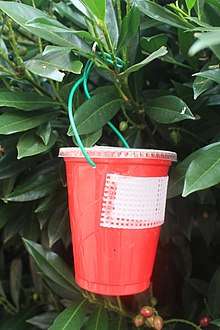
Due to the impact of D. suzukii on soft fruits, farmers have started to monitor and control it. There are different types of traps, both commercial and home-made, that are effective in monitoring it. Traps that use apple cider vinegar with a whole wheat dough bait have been successful for farmers to both capture and monitor D. suzukii.[21] Farmers are advised to place these traps in a shaded area as soon as the first fruit is set and to not remove them until the end of harvest. The traps should be checked once a week and farmers should look for the spot on the wing of the males to determine if D. suzukii is present.[22]
In areas where D. suzukii has already been established or where its activity has been monitored, there are different ways to control it. One way to manage D. suzukii is to remove the infested fruit and place it in a plastic bag in the garbage. This method is effective from removing D. suzukii from gardens and small areas but is difficult for farmers with larger operations to do this. Farmers can also harvest their soft fruit early which reduces the exposure of fruit to D. suzukii and the likelihood of damage.[23]
Farmers have the option of both conventional and organic sprays [24] to control D. suzukii. Timing of the sprays is important to effectively controlling it. Since D. suzukii is more active in the morning and evening those are the best times to control it.[25] Sprays should be in place prior to egg laying and the coverage needs to be thorough because adults often hide in dense portion of the canopy. Depending on the variety of soft fruit and laws in different states and countries, there are many types of organic and conventional sprays that are effective. Different laws and pre-harvest date intervals need to be kept in mind when choosing a type of spray. Most types of sprays need to be applied each week, at a minimum. To prevent resistance to certain sprays, farmers must rotate among different insecticides.[26]
Microbiome
Drosophila suzukii, like all insects, is host to a variety of microorganisms. The intestinal bacterial communities of adult and larval D. suzukii collected in its invasive range (USA), were found to be simple and mostly dominated by Tatumella sp. (Enterobacteriaceae).[27] This fly is also infected with a variety of viruses in the wild. Whilst sharing some natural viruses with its close relative D. melanogaster, D. suzukii also harbours a number of unique viruses specific to it alone.[28] Yeasts also form an important part of the Drosophila microbiome, with a mutualistic relationships to yeast being described in other Drosophila species.[29][30][31] The yeast species found to be most frequently associated with D. suzukii were Hanseniaspora uvarum, Metschnikowia pulcherrima, Pichia terricola, and P. kluyveri.[32] Although certain fungal pathogens have been shown to experimentally infect D. suzukii,[33][34][35] the wild fungal infections of D. suzukii remain to be explored comprehensively.
Gallery
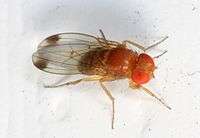 Male Drosophila suzukii, note the dark spots near his wing tips
Male Drosophila suzukii, note the dark spots near his wing tips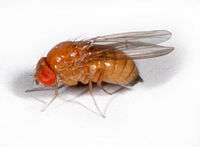 Female Drosophila suzukii, her wings are without spots
Female Drosophila suzukii, her wings are without spots Male Drosophila suzukii
Male Drosophila suzukii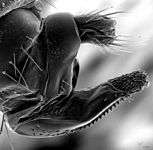 Electron microscope image of an ovipositor of a female Drosophila suzukii
Electron microscope image of an ovipositor of a female Drosophila suzukii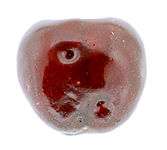 Cherry with oviposition scars of Drosophila suzukii
Cherry with oviposition scars of Drosophila suzukii
References
- Matsumura, S. (1931). 6000 illustrated insects of Japan-Empire (in Japanese). Tokyo, Japan: Toko Shoin. pp. 1689 [367].
- Walsh, Douglas B.; Bolda, Mark P.; Goodhue, Rachael E.; Dreves, Amy J.; Lee, Jana; Bruck, Denny J.; Walton, Vaughn M.; O'Neal, Sally D.; Zalom, Frank G. (2011). "Drosophila suzukii (Diptera: Drosophilidae): invasive pest of ripening soft fruit expanding its geographic range and damage potential". Journal of Integrated Pest Management. 2 (1): G1–G7. doi:10.1603/IPM10010.
- Kanzawa, T. 1939 Report. Translated from Japanese by Shinji Kawaii
- Walsh, D. Press Release, Washington State University. 2009 Archived August 6, 2010, at the Wayback Machine
- Mark P. Bolda; Rachael E. Goodhue & Frank G. Zalom (2009). Spotted Wing Drosophila: Potential Economic Impact of Newly Established Pest (PDF). Giannini Foundation of Agricultural Economics, University of California.
- Spotted Wing Drosophila (Fruit Fly) Pest Alert. British Columbia Ministry of Agriculture and Lands. December 2009. http://www.agf.gov.bc.ca/cropprot/swd.htm Archived 2010-03-28 at the Wayback Machine
- Steck, G, Dixon, W, Dean, D. Pest Alert, Spotted Wing Drosophila, a fruit pest new to North America. 2009
- Spotted Wing Drosophila. NC Small Fruit, Specialty Crop, and Tobacco IPM. 2010. http://ncsmallfruitsipm.blogspot.com/p/spotted-wing-drosophila.html
- Spotted Wing Drosophila. Louisiana Department of Agriculture and Horticulture. August 2010. "Archived copy" (PDF). Archived from the original (PDF) on 2011-01-12. Retrieved 2011-01-18.CS1 maint: archived copy as title (link)
- Davis, R., Alston, D., Vorel, C. Spotted Wing Drosophila September 2010. http://extension.usu.edu/files/publications/publication/ENT-140-10.pdf
- Early detection program finds a new invasive pest of fruit in Michigan MSU Fruit Crop Advisory Team Alert, 29 Oct 2010. "Archived copy". Archived from the original on 2011-07-20. Retrieved 2010-10-29.CS1 maint: archived copy as title (link)
- Hamilton, K. Wisconsin Pest Bulletin. 19 November 2010.
- "Spotted Wing Drosophila IPM Working Group". NortheastIPM.org. 2012-11-13. Retrieved 2019-11-19.
- "Spotted Wing Drosophila | Minnesota Department of Agriculture". www.mda.state.mn.us. Retrieved 2019-11-19.
- Belgian Journal of Zoology - Drosophila suzukii (Diptera: Drosophilidae): A pest species new to Belgium. - Link
- Drosophila suzukii (Diptera: Drosophilidae): Spotted wing drosophila. European and Mediterranean Plant Protection Organization. January 2010. http://www.eppo.org/QUARANTINE/Alert_List/insects/drosophila_suzukii.htm Archived 2010-08-01 at the Wayback Machine
- Herring, P. Grant funds help regional effort to combat spotted wing drosophila. 29 April 2010. http://extension.oregonstate.edu/news/story.php?S_No=729&storyType=news.
- McEvey, Shane (13 February 2017). "High resolution diagnostic images of Drosophila suzukii (Diptera: Drosophilidae)". doi:10.6084/m9.figshare.4644793.v1. Cite journal requires
|journal=(help) - Spotted Wing Drosophila, Drosophila suzukii: A New Pest in California. UC IPM Online, 10 Apr 2010. http://www.ipm.ucdavis.edu/EXOTIC/drosophila.html Archived 2016-04-30 at the Wayback Machine
- "USDA Awards $6.7 Million To Stifle Spotted Wing Drosophila". Growing Produce. 2015-10-20. Retrieved 2019-11-19.
- "Monitoring | Cornell Fruit Resources". fruit.cornell.edu. Retrieved 2019-11-14.
- "Spotted wing drosophila in home gardens". extension.umn.edu. Retrieved 2019-11-14.
- "Spotted Wing Drosophila Management Guidelines--UC IPM". ipm.ucanr.edu. Retrieved 2019-11-14.
- Dam, Doriane; Molitor, Daniel; Beyer, Marco (2019). "Natural compounds for controlling Drosophila suzukii". Agronomy for Sustainable Development. 39 (6). doi:10.1007/s13593-019-0593-z.
- "New guide to organic management of spotted wing Drosophila released". Organic Agriculture. Retrieved 2019-11-14.
- "Spotted Wing Drosophila Management | Entomology". entomology.ca.uky.edu. Retrieved 2019-11-14.
- Chandler, James Angus; James, Pamela M.; Jospin, Guillaume; Lang, Jenna M. (2014-07-22). "The bacterial communities of Drosophila suzukii collected from undamaged cherries". PeerJ. 2: e474. doi:10.7717/peerj.474. ISSN 2167-8359. PMC 4121540. PMID 25101226.
- Medd, Nathan C; Fellous, Simon; Waldron, Fergal M; Xuéreb, Anne; Nakai, Madoka; Cross, Jerry V; Obbard, Darren J (2018-01-01). "The virome of Drosophila suzukii, an invasive pest of soft fruit". Virus Evolution. 4 (1): vey009. doi:10.1093/ve/vey009. PMC 5888908. PMID 29644097.
- Anagnostou, Christiana; Dorsch, Monika; Rohlfs, Marko (2010-07-01). "Influence of dietary yeasts on Drosophila melanogaster life-history traits". Entomologia Experimentalis et Applicata. 136 (1): 1–11. doi:10.1111/j.1570-7458.2010.00997.x. ISSN 1570-7458.
- Starmer, William T. (1981-01-01). "A comparison of Drosophila habitats according to the physiological attributes of the associated yeast communities". Evolution. 35 (1): 38–52. doi:10.1111/j.1558-5646.1981.tb04856.x. ISSN 1558-5646. PMID 28563455.
- Simmons, Fred H; Bradley, Timothy J (1997). "An analysis of resource allocation in response to dietary yeast in Drosophila melanogaster". Journal of Insect Physiology. 43 (8): 779–788. doi:10.1016/s0022-1910(97)00037-1. PMID 12770456.
- Hamby, Kelly A.; Hernández, Alejandro; Boundy-Mills, Kyria; Zalom, Frank G. (2012-07-15). "Associations of Yeasts with Spotted-Wing Drosophila (Drosophila suzukii; Diptera: Drosophilidae) in Cherries and Raspberries". Applied and Environmental Microbiology. 78 (14): 4869–4873. doi:10.1128/aem.00841-12. ISSN 0099-2240. PMC 3416361. PMID 22582060.
- Woltz, J. M.; Donahue, K. M.; Bruck, D. J.; Lee, J. C. (2015-12-01). "Efficacy of commercially available predators, nematodes and fungal entomopathogens for augmentative control of Drosophila suzukii". Journal of Applied Entomology. 139 (10): 759–770. doi:10.1111/jen.12200. ISSN 1439-0418.
- Cuthbertson, Andrew G. S.; Collins, Debbie A.; Blackburn, Lisa F.; Audsley, Neil; Bell, Howard A. (2014-06-20). "Preliminary Screening of Potential Control Products against Drosophila suzukii". Insects. 5 (2): 488–498. doi:10.3390/insects5020488. PMC 4592600. PMID 26462696.
- Becher, Paul G.; Jensen, Rasmus E.; Natsopoulou, Myrsini E.; Verschut, Vasiliki; Licht, Henrik H. De Fine (2018-03-01). "Infection of Drosophila suzukii with the obligate insect-pathogenic fungus Entomophthora muscae". Journal of Pest Science. 91 (2): 781–787. doi:10.1007/s10340-017-0915-3. ISSN 1612-4758. PMC 5847158. PMID 29568251.
External links
| Wikispecies has information related to Drosophila suzukii |
| Wikimedia Commons has media related to Drosophila suzukii. |
- Pest Alert: Spotted Wing Drosophila, Oregon Department of Agriculture
- Oregon State University horticulture site
- Washington State University
- Michigan State University Spotted Wing Drosophila site
- Spotted wing drosophila on the UF / IFAS Featured Creatures Web site
- Species Profile - Spotted Wing Drosophila (Drosophila suzukii), National Invasive Species Information Center, United States National Agricultural Library.
Further reading
- Bellamy, David E.; Sisterson, Mark S.; Walse, Spencer S. (2013). "Quantifying Host Potentials: Indexing Postharvest Fresh Fruits for Spotted Wing Drosophila, Drosophila suzukii". PLOS One. 8 (4): 1–10. Bibcode:2013PLoSO...861227B. doi:10.1371/journal.pone.0061227. PMC 3625224. PMID 23593439.
- Hamby, Kelly A.; Kwok, Rosanna S.; Zalom, Frank G.; Chiu, Joanna C. (2013). "Integrating Circadian Activity and Gene Expression Profiles to Predict Chronotoxicity of Drosophila suzukii Response to Insecticides". PLOS One. 8 (7): 1–14. Bibcode:2013PLoSO...868472H. doi:10.1371/journal.pone.0068472. PMC 3702611. PMID 23861907.
- Mazzoni, Valerio; Anfora, Gianfranco; Virant-Doberlet, Meta (2013). "Substrate Vibrations During Courtship in Three Drosophila species". PLOS One. 8 (11): 1–8. Bibcode:2013PLoSO...880708M. doi:10.1371/journal.pone.0080708. PMC 3829934. PMID 24260459.
- Kacsoh, Balint Z.; Schlenke, Todd A. (2012). "High Hemocyte Load is Associated with Increased Resistance Against Parasitoids in Drosophila suzukii, a Relative of D. melanogaster". PLOS One. 7 (4): 1–16. Bibcode:2012PLoSO...734721K. doi:10.1371/journal.pone.0034721. PMC 3328493. PMID 22529929.